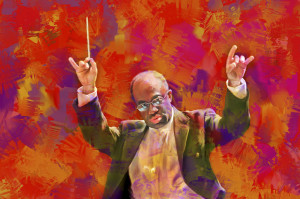The Legacy Project Honorees See the Flipping Book of Honoree Portraits.
Michael Morgan was born in Washington, D.C., where he attended public schools and began conducting at the age of 12. While a student at Oberlin College Conservatory of Music, he spent a summer at the Berkshire Music Center at Tanglewood. There he was a student of Gunther Schuller and Seiji Ozawa, and it was at that time that he first worked with Leonard Bernstein.
In 1980, he won first prize in the Hans Swarovsky International Conductors Competition in Vienna, Austria and became Assistant Conductor of the Saint Louis Symphony Orchestra, under Leonard Slatkin. His operatic debut was in 1982 at the Vienna State Opera in Mozart’s The Abduction from the Seraglio. In 1986, Sir Georg Solti chose him to become the Assistant Conductor of the Chicago Symphony Orchestra, a position he held for five years under both Solti and Daniel Barenboim. In 1986 he was invited by Leonard Bernstein to make his debut with the New York Philharmonic. As a guest conductor he has appeared with most of America’s major orchestras as well as the New York City Opera, St. Louis Opera Theater and Washington National Opera.
In 2005, he received two national awards by major music associations, the San Francisco Chapter of The Recording Academy with the 2005 Governor’s Award for Community Service and, on the opposite coast, the American Society of Composers, Authors and Publishers (ASCAP) as one of its five Concert Music Award recipients.
Among innovations, Morgan created a new Philharmonic Artistic & Cultural Initiative Team (ACIT) composed of board members, musicians, staff and community members who work with Maestro Morgan to develop programming that is responsive to Sacramento community needs and interests.
Morgan continues to draw attention, most recently in a feature article in the Nov. 4, 2011 issue of the New York Times. He has been called “a trailblazer” for his vision, which matches classic and 20th-century pieces with contemporary pieces by local composers – all with an intention of building community through music. Morgan notes, “The thing I find most interesting about orchestras is using them to bring the town together…We want the fans of this music and that music, who may never see each other in real life, to come and watch a concert together…The orchestra is more than a vehicle for pretty music.”
“The most fundamental thing is the ability to translate the way a piece should sound into physical gesture, which is actually a fairly rare talent — that’s why there are so many conductors, and so few people who are really good at it. The other thing is figuring out what your real contribution to the field is, which is different for each person. Finding the thing that’s important to you is what really makes you not just successful but also content in the success you’re having.” Michael Morgan

